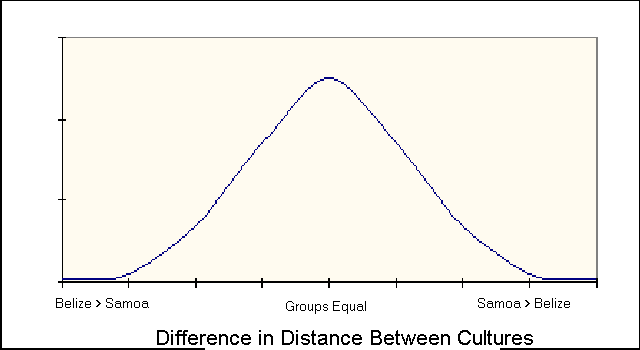Most researchers agree that stating expectations is a useful tool in data analysis. Additionally, most researchers will argue this should be done long before data analysis (ideally, long before data collection).
Your goals for this section are:
1) State your expectations based on literature or previous research.
2) Distinguish between one-tailed and two-tailed hypotheses.
For this part of the exercise, your goal is to state, in plain English, what you expect to find in the data (a formal hypothesis will be stated later).
Most hypothesis formation begins with a review of relevant literature. Imagine that a review of the literature regarding the cultures of Belize and Samoa yielded the following information:
Belize and Samoa differ in child rearing styles. Mothers in Belize tend to be very protective of their children while mothers in Samoa tend to let their children roam and explore.
Based on the above short description, what is your initial expectation? That is, what differences do you expect to find in your data between Belize and Samoa?
There is no difference between Belize and Samoa
This answer is incorrect. There are actual differences expected between Belize and Samoa. Recall the statement on the previous page “mothers in Belize tend to keep their children very close to their bodies while mothers in Samoa tend to let their children roam and explore.”
This statement would imply that we would expect some differences between the two countries.
If your choice had been correct, then the statement about the two countries might read as follows: Mothers in Belize tend to keep children close to their bodies, as do mothers in Samoa.
There is a difference between Belize and Samoa
This answer is partially correct but, it is not the most correct answer. In this situation we believe that there is a difference between the two groups but we also have reason to suspect that the difference is in a particular direction (i.e. the children in one culture, on average, are further from their mothers than the children in the other culture). Specifically, we believe mothers in Belize tend to keep their children very close to their bodies while mothers in Samoa tend to let their children roam and explore.
Children in Belize are farther from their mothers than children in Samoa
Incorrect. The previous statement says “mothers in Belize tend to keep their children very close to their bodies while mothers in Samoa tend to let their children roam and explore.”
If your choice had been correct, the statement regarding the two countries might have read as follows: Mothers in Belize tend to let their children roam and explore whereas mothers in Samoa are more likely keep their children very close to their bodies.
Children in Samoa are farther from their mothers than children in Belize
Correct! This is exactly what the literature points to. Usually, hypotheses based on some previous research or theorization.
Ask the Expert
In general, an expectation or hypothesis is based on previous information, often times found in the vast literature available on any given topic. It is important to examine the information given you and draw inferences about what that information implies for the data at hand.
The information we have is as follows:
Mothers in Belize tend to keep their children very close to their bodies while mothers in Samoa tend to let their children roam and explore. How would you test a hypothesis using our data?
Some important questions to ask yourself here are?
- 1. What does the statement say about Belize?
- 2. What does it say about Samoa?
- 3. What does it say about the differences between Samoa and Belize?
Now, thinking about the direction of the relationship, what type of hypothesis statement is this?
One-tailed
Correct. A one tailed hypothesis specifies a directional relationship between groups. Here we are saying that we expect children in Samoa to be further from their mothers than children in Belize. We not only state that there will be differences between the groups but we specify in which direction the differences will exist. Anytime we expect a relationship to be directional (i.e. to go one specific way) we are using a one-tailed hypothesis. This is the opposite of a two-tailed hypothesis. A two tailed hypothesis would predict that there was a difference between groups, but, would make no reference to the direction of the effect.
Two-tailed
Incorrect. A two tailed hypothesis would state that Belize and Samoa would differ ,but it would not state the direction in which we expect the groups to differ. Our hypothesis does state a specific directional relationship (i.e. Belize children closer than children in Samoa. A one tailed hypothesis (like our hypothesis which states that we expect Samoan children to be further away from their mothers than we expect Belize children to be), is concerned with differences that occur only in one tail of our distribution.
Ask the Expert
The key to understanding the difference between one and two tailed hypotheses lies in understanding the concept of the direction of a relationship. Direction refers to the manner in which we are expecting our differences to occur.

Consider the picture above. This shows us that there are two ways in which our groups can be different. 1) Belize children can be further from their mothers than children in Samoa or 2) Samoan children can be further from their mothers than children in Belize. These two ways to be different comprise the two “tails” of our distribution. To decide whether we have a one or two tailed hypothesis, all we have to do is decide how many of our tails (or ways to be different) are considered in our hypothesis statement.
![]()

